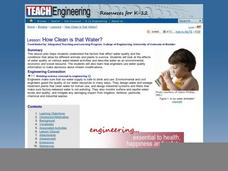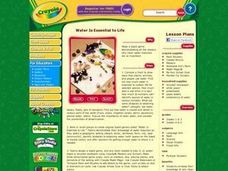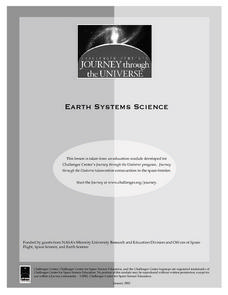American Museum of Natural History
Be a Water Saver
Everyone must do their part to make a difference. The lesson link provides an 11-item questionnaire to reflect on conservation practices. Simple and straightforward, the lesson is perfect as a remote learning resource or as a tool for an...
Curated OER
How Clean is the Water?
Students read about and discuss water and how it is used as a resource and how engineers use technology to preserve it. In this water lesson plan, students look at a picture of water treatment and tell what is wrong with the picture.
Curated OER
Meet the Plants
Are you looking for a PowerPoint that identifies and explains the job each plant part performs? Perhaps you've found it! Examples of different types of plants, as well as common household items derived from plants are included. The text...
Curated OER
Water is Essential to Life
Young scholars increase their knowledge of why clean water resources are essential to the survival of plants, animals, and people. They deomonstrate their understanding of the role of water for sustaining life by creating an original...
Curated OER
Water Plants
Young scholars examine the plants and animals that make their home in wetlands. While observing, they make sketches of the ones they see with a pencil. To end the lesson plan, they use watercolors to paint their flowers and animals at...
Captain Planet Foundation
Adopt-A-Plant
Note the way that plants change during the season by adopting a plant on your school campus. After your class chooses their plant, they research the plant's needs, how it differs from other plants, find ways to support their plant's...
ARKive
Plants
Here is a one-hour activity that helps learners remember the parts of plants. Not only will the class learn about plant parts, they'll also discuss seed dispersal and plant growth. A celery experiment is used to show how plants obtain...
Curated OER
Third Grade Science
In this science worksheet, 3rd graders answer multiple choice questions about measurement, plants, water, fossils, and more. Students complete 25 questions.
Curated OER
Benefits of Indoor Plants
Learners diagram a plant. In this Science lesson, students explore the concept of photosynthesis focusing on the oxygen production. Learners calculate the amount of plants needed to filter the air in their classroom.
Cornell University
Sun or Water? or Both?
Over the course of 10 days, young scientists observe their cups of seed and soil—one that gets sun and water and one that gets no sun and only water. Then they reflect on the results of the experiment to determine if their hypothesis was...
Michigan Sea Grant
What's in This Water?
Pupils investigate the biological and chemical characteristics of water to determine where purple loosestrife occurs. They create data sheets to record water quality tests in several locations and work in groups to conduct the water...
Curated OER
Water Pollution
Examine water pollution and legislation through this reading comprehension worksheet, intended to correspond with a specific text but valuable even without it. Learners read 10 sentences, unscrambling the bold word to complete each (i.e....
Curated OER
The Great Water Hunt
Students examine a globe to locate the bodies of water present and create a representation of those bodies of water for further exploration of the concept. Extensions of their observations are made at school, home, and the community.
Curated OER
WET Science Lesson #11: How Light Affects Water
Scientists listen to the story of Wadja Egnankou who works to save African mangrove forests. They experiment with refraction and the introduction of particulate matter to water. They conclude with creative writing about the need for a...
Curated OER
soil, Water, and Plants
Students examine the relationship between water retention and plant growth by conducting two experiments. They first compare the water retention qualities of clay, sand and loam soil types. Then they use the data from the first...
Curated OER
Plant Parts and their Function
Discover why plants are important to our world. View plant parts and categorize them as stems or buds. Students do a cut and paste of pictures of plants into correct categories. Students also plant a carrot top,and record the growth and...
Curated OER
Water Filtration
As an example of nature's water filtering system, young ecologists conduct an experiment in the lab. They construct a funnel out of a plastic bottle, fill it with specified layers of materials that simulate layers of soil, then run muddy...
Curated OER
Transport in Plants
Quite a detailed and advanced look at the transport mechanisms of a plant. The absorption and control of sugar and water concentration are explained and will help an understanding of homeostasis concepts and organ specialization.
Curated OER
Plants have needs, too!
Plants can die if they don't get enough sunlight and water. Kindergartners observe a picture of a hanging plant and grass under a tree, and interpret which each plant has died. Next, they grow watercress seeds in wet cotton to compare...
Foundation for Water & Energy Education
How Can Work Be Done with Water Power? Activity B
In this second of three activities, energy engineers plan and create a hydropower dam as they learn how hydroelectric power plants generate electricity. A hydropower puzzle is also included, which can be worked on by teams that finish...
Curated OER
Common Pond Plants and Invertebrates
Here is a wordsearch that has learners find 18 different organisms that are commonly-found in pond environments. The monarch butterfly, cotton grass, water flea, and the damesfly are just a few of the organisms found. Colorful and...
San Francisco Public Utilities Commission
What is Drought? No Rain, No Water
How can climate change affect our water supply? Have kids read a passage about the water cycle and water conservation, which includes six questions that challenge them to use context clues.
K12 Reader
Plants Are Producers
Here's a handy two-part activity that uses an article about plants to assess reading comprehension. After reading the passage, kids answer questions based on the information in the text.
Biology Junction
Nonvascular and Simple Vascular Plants: Mosses to Ferns
Sometimes conservationists use specific plants to prevent erosion or fight invasive species. A 50-slide presentation covers both nonvascular and vascular plants. It discusses the plants, their stages and life cycles, reproduction, uses,...
Other popular searches
- Water Treatment Plants
- Compare Water and Land Plants
- Animals Plants and Water
- Plants Clean Water
- Water Transport in Plants
- Waste Water Treatment Plants
- Dirty Water Plants
- Water Plants
- Water and Plant Life
- Water Transport and Plants
- Plants and Water Movement
- Water Cycle Plants

























